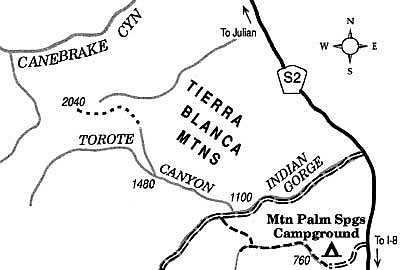 Facebook
Facebook
 X
X
 Instagram
Instagram
 TikTok
TikTok
 Youtube
Youtube
Dozens of elephant trees cling to the walls of Torote Canyon, a tributary of Indian Gorge in the southern reaches of Anza-Borrego Desert State Park. In Mexico, this tree is called torote, which means "twisted," in reference to the haphazard way the limbs twine upward. On the California side of the border, elephant trees are relatively rare, confined to a few spots scattered throughout the park.
With a short, stubby trunk, puffy limbs, reddish twigs and sap, tiny green leaves, and purplish fruit, elephant trees are definitely weird. Indians believed the plant was associated with a great power capable of curing many diseases, especially skin ailments. Shamans kept the sap from the plant hidden away, as it was considered too dangerous for casual use.
A series of secluded valleys, each seemingly cut off from the rest of the world, lie one to two miles up Torote Canyon. A broad expanse of sand, a few sparse shrubs, cobbled walls in the distance, and the blue vault of sky overhead: an hour spent in the warm February sunshine quietly contemplating such purity and simplicity can bring on a feeling of profound peace.
All but low-clearance passenger cars should be capable of negotiating the sandy road (turnoff at mile 46.1 on Highway S-2, about 2 miles north of Bow Willow) leading into Indian Gorge. Drive 1.8 miles to where a small post indicates the mouth of Torote Canyon on the right (north). On foot, scramble up the rock-strewn bed of the canyon, passing elephant trees tenaciously clinging to the steep walls.
After 0.8 mile you enter the first valley, a nearly flat, sand-drowned expanse stretching nearly half a mile. Within this valley the canyon divides, with the main branch (Torote Canyon) climbing sharply up a bouldered crease on the left (northwest). Keep right, if you prefer, toward the far end of the valley, and proceed north into a small, narrow canyon, a tributary of Torote Canyon. Within 200 yards this broadens into a second valley, similar to the first. Continue northwest to the second valley's end, and climb to the low pass appearing straight ahead. By contouring over rocks to the left (west), you can reach the east end of still another sand-drowned valley -- this one richly endowed with desert vegetation and madly dashing jackrabbits.


Dozens of elephant trees cling to the walls of Torote Canyon, a tributary of Indian Gorge in the southern reaches of Anza-Borrego Desert State Park. In Mexico, this tree is called torote, which means "twisted," in reference to the haphazard way the limbs twine upward. On the California side of the border, elephant trees are relatively rare, confined to a few spots scattered throughout the park.
With a short, stubby trunk, puffy limbs, reddish twigs and sap, tiny green leaves, and purplish fruit, elephant trees are definitely weird. Indians believed the plant was associated with a great power capable of curing many diseases, especially skin ailments. Shamans kept the sap from the plant hidden away, as it was considered too dangerous for casual use.
A series of secluded valleys, each seemingly cut off from the rest of the world, lie one to two miles up Torote Canyon. A broad expanse of sand, a few sparse shrubs, cobbled walls in the distance, and the blue vault of sky overhead: an hour spent in the warm February sunshine quietly contemplating such purity and simplicity can bring on a feeling of profound peace.
All but low-clearance passenger cars should be capable of negotiating the sandy road (turnoff at mile 46.1 on Highway S-2, about 2 miles north of Bow Willow) leading into Indian Gorge. Drive 1.8 miles to where a small post indicates the mouth of Torote Canyon on the right (north). On foot, scramble up the rock-strewn bed of the canyon, passing elephant trees tenaciously clinging to the steep walls.
After 0.8 mile you enter the first valley, a nearly flat, sand-drowned expanse stretching nearly half a mile. Within this valley the canyon divides, with the main branch (Torote Canyon) climbing sharply up a bouldered crease on the left (northwest). Keep right, if you prefer, toward the far end of the valley, and proceed north into a small, narrow canyon, a tributary of Torote Canyon. Within 200 yards this broadens into a second valley, similar to the first. Continue northwest to the second valley's end, and climb to the low pass appearing straight ahead. By contouring over rocks to the left (west), you can reach the east end of still another sand-drowned valley -- this one richly endowed with desert vegetation and madly dashing jackrabbits.
